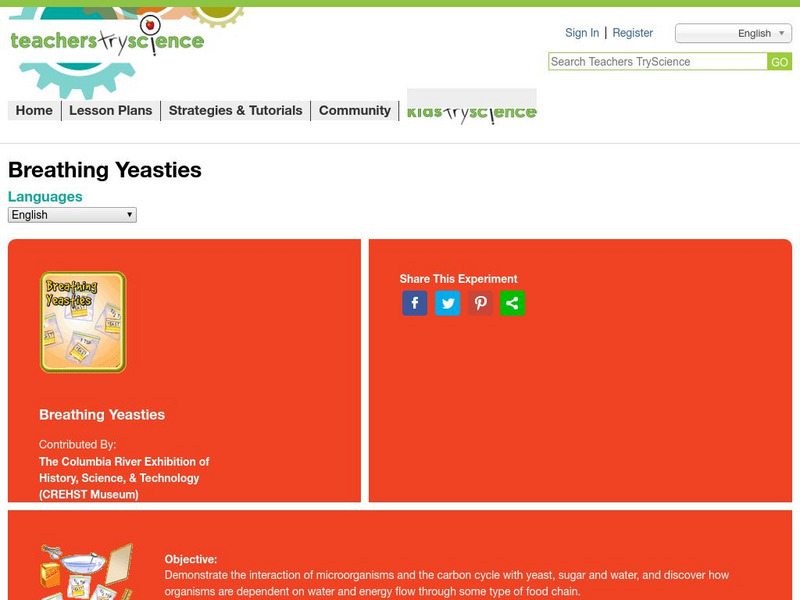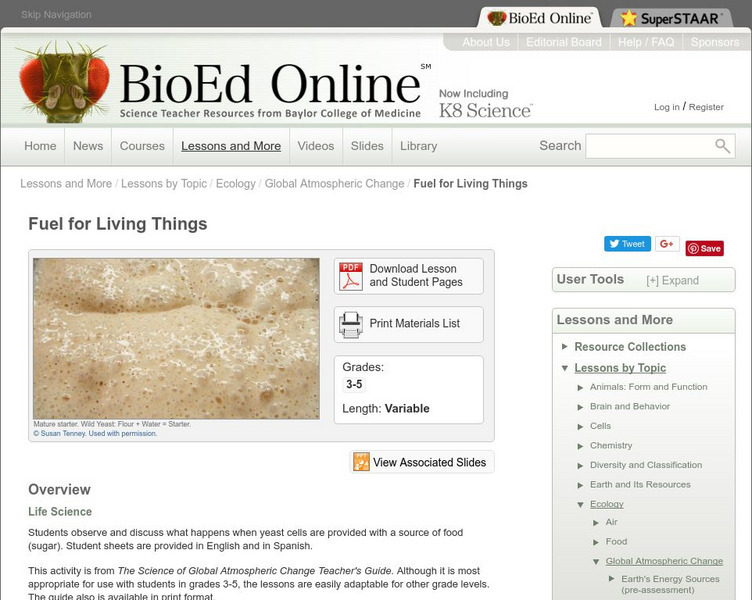Hi, what do you want to do?
Curated OER
Pretzel Mania
In this lesson, students enhance their number and letter recognition. Students make letters and numbers with pretzel dough. Students prepare the pretzel dough, shape it, bake it, and eat it. In this lesson, students test their...
Curated OER
Recipe for Beignets
In this reading and following directions activity, students read and make New Orleans beignets. Students follow 10 directions.
Curated OER
Science Test B-Grade 5
In this grade 5 science test worksheet, 5th graders complete a 30 question multiple choice quiz covering a variety of grade 5 concepts.
Curated OER
Can You "Gas" What's Happening?
Students examine gas production in "soil" samples through hands on activities and class discussions, to determine if the soil samples have contain living or non-living systems.
Curated OER
BIO205-CH1- Intro Word Search
In this word search activity, students locate words related to biology. The word list includes protists, viruses, plants, spiral, and biotechnology.
Curated OER
Super Star Nutrition for Kids
In this nutrition worksheet, 3rd graders study food labels and label fruits and vegetables. Students respond to 2 short answer questions and complete 26 fill in the blank questions writing the name of a fruit or vegetable that...
Curated OER
Kernel Power" Ethanol Fuel from Corn
Students study why corn is a biodegradable, renewable resource. In this ethanol lesson students build models and observe a chemical reaction.
Curated OER
Chemical Changes
Sixth graders explore chemical and physical changes. In this lesson about chemical changes, 6th graders observe various items and changes that occur at certain times. Students determine what change took place and observe the change....
Curated OER
Chemical Changes
Young scholars compare types of chemical change. In this chemical reaction instructional activity, students use a variety of household items to investigate different types of chemical change. Young scholars will engage in a discussion...
Curated OER
Microbe Experimentation
Seventh graders study microorganisms in their environments by experimenting with milk products. In this microbes lesson plan, 7th graders read background information about microorganisms in yogurt and soured milk. Students then follow a...
Curated OER
Reading Labels
In this food labels worksheet, students answer short answer questions and multiple choice questions based on the food labels they are given. Students complete 4 activities.
Curated OER
Our Food and Microorganisms
Students answer questions about how microorganisms can affect our food supply and how they can be controlled. The first set of inquiry activities are directed by the teacher. Subsequent activities are based on students generating their...
Curated OER
From Seed to Bread
Students examine how some of their food comes from plants by baking bread. They listen to teacher read alouds that set the stage for the activity.
Curated OER
Little Red Hen
Students explore the story of the Little Red Hen. They listen to and discuss the story, create puppets and retell the story, and make bread using a bread in a bag recipe.
Curated OER
Does the Chicken have Anthrax (Explain I)
Students explain how each of the components of innate immunity function in the protection of the body. Following an investigation, they articulate how innate immunity functions.
Science Buddies
Science Buddies: Yeast Reproduction in Sugar Substitutes
There's nothing quite like the smell of fresh-baked bread to make your mouth water. As any baker can tell you, you can't bake bread without yeast. This project makes clever use of bread dough to measure yeast reproduction three different...
Bio Topics
Bio Topics: To Monitor the Progress of Fermentation of Different Sugars by Yeast
In this classroom lab experiment students measure progress of sugar fermentation by yeast using a hydrometer.
University of Missouri
Microbes in Action: Classroom Activities: A Swell Lab: Yeast Fermentation [Pdf]
This two-day experiment uses different concentrations of sugar to study the rate of fermentation. Students observe the rate of carbon dioxide gas produced by yeast to infer the rate of fermentation. Lesson plan gives a lab procedure,...
TeachEngineering
Teach Engineering: Sugar Spill!
In this activity, students act as environmental engineers involved with the clean up of a toxic spill. Using bioremediation as the process, students select which bacteria they will use to eat up the pollutant spilled. Students learn how...
Teachers TryScience
Teachers Try Science: Breathing Yeasties
See how combining yeast, sugar, and water can demonstrate the carbon cycle and show how microorganisms work in the food chain.
BioEd Online
Bio Ed Online: Fuel for Living Things
Students learn about how cells fuel themselves by examining how carbon dioxide is produced by yeast cells when the cells feed on sugar. The carbon dioxide is detected through the use of a red cabbage indicator that reacts in the presence...
TeachEngineering
Teach Engineering: Microbes Know How to Work!
Students design systems that use microbes to break down a water pollutant (in this case, sugar). They explore how temperature affects the rate of pollutant decomposition.






















![Microbes in Action: Classroom Activities: A Swell Lab: Yeast Fermentation [Pdf] Activity Microbes in Action: Classroom Activities: A Swell Lab: Yeast Fermentation [Pdf] Activity](https://static.lp.lexp.cloud/images/attachment_defaults/resource/large/FPO-knovation.png)



